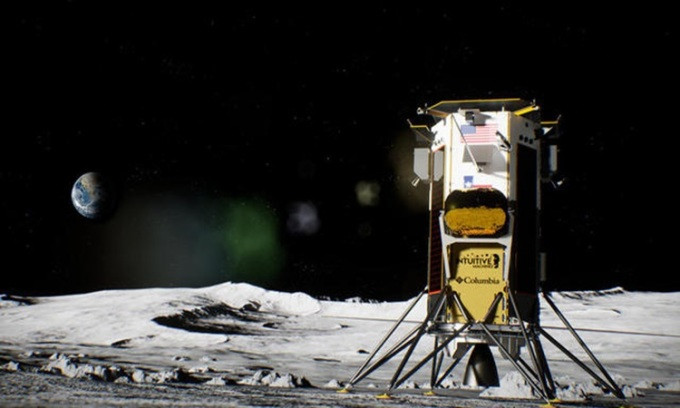Intuitive Machines' Odysseus spacecraft made history when it became the first private spacecraft to land gently on the Moon in the early morning of February 23, Hanoi time.

Simulation of Odysseus landing on the Moon
After a tense descent and silence from the lunar surface, the Odysseus lander, built by Houston-based Intuitive Machines, touched down near the south pole on February 22. It was a momentous moment for space exploration. No private spacecraft had ever landed softly on the moon before, and no American vehicle had touched down on the celestial body since the manned Apollo 17 landing in December 1972.
"It's a victory! Odysseus has reached the Moon," NASA Administrator Bill Nelson said after confirming the successful landing. "This is a giant leap for all mankind."
NASA plans to build a human base for its Artemis program on the Moon’s south pole, which is believed to contain a lot of water ice. But before sending astronauts there, NASA wants to collect more data about this little-explored region, such as how much water there is and how easily accessible it is. So NASA created another program called CLPS (Commercial Lunar Payload Services), which allows American companies to develop autonomous lunar landers carrying scientific equipment.
In 2019, CLPS selected Intuitive Machines to deliver NASA’s scientific equipment to the lunar surface, using the company’s Nova-C lander, which was about the size of a phone booth in the UK. After some modifications, the $118 million mission was born. The lander carried six experiments and NASA technology testing equipment on Intuitive Machines’ first mission to the moon, called IM-1. That mission used a Nova-C vehicle called Odysseus, named after the famous hero of Greek mythology.
NASA’s $11 million development fleet is designed to conduct a range of explorations. For example, the NDL (Navigation Doppler Lidar for Precise Velocity and Range Sensing) instrument uses ground-penetrating radar (LIDAR) technology to collect data during descent and landing. Another instrument is designed to study how the spacecraft’s engine exhaust interacts with lunar soil. The spacecraft also carries equipment to test autonomous positioning technology as part of a larger GPS-like positioning system around the moon.
Intuitive Machines also carried six commercial payloads aboard Odysseus during the IM-1 mission. One was from Columbia Sportswear, which wanted to test its Omni-Heat Infinity insulation material in deep space, and a series of sculptures by artist Jeff Koons. Odysseus also carried EagleCam, a camera system built by students at Embry-Riddle Aeronautical University. EagleCam was deployed from Odysseus, 100 feet above the lunar surface, and photographed the lander’s descent from below.
On February 15, SpaceX’s Falcon 9 rocket launched the Odysseus spacecraft on its journey to the Moon. The lander’s deep-space flight was relatively short and smooth, and the Odysseus reached lunar orbit on February 21 as scheduled. However, during landing, mission controllers discovered that the Odysseus’ laser photogrammetric camera (which helps determine altitude and horizontal speed) was not functioning properly. So the team used NASA’s NDL test rig to continue this important function, delaying the landing by two hours.
The last-minute solution, which required the team to design software from the ground and transmit it to the Odysseus, worked. At 6:11 p.m. on February 22 (US time) or 5:11 a.m. on February 23 (Hanoi time), Odysseus fired its main engine for 11 minutes to help the spacecraft slow down its descent to the lunar surface. Then, at 6:23 p.m. US time the same day (5:23 a.m. on February 23, Hanoi time), the Odysseus landed gently near the rim of the Malapert A crater, about 300 km from the lunar south pole. The IM-1 team spent a tense 15 minutes waiting for a signal from the Odysseus.
If all goes according to plan, the lander and its scientific instruments will operate for about seven Earth days on the Moon. The IM-1 mission will end when the sun sets on Malapert A, as Odysseus is not designed to survive the cold conditions of the long lunar night.
TH (according to VnExpress)